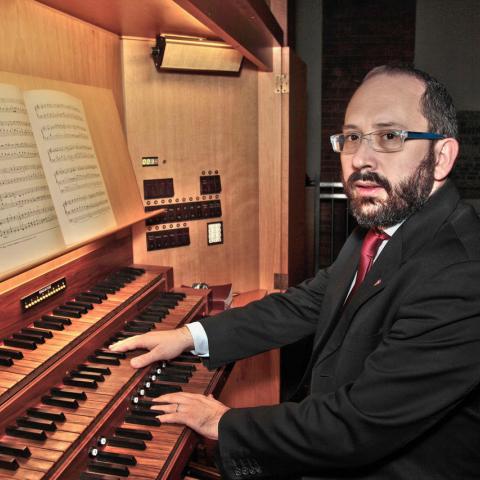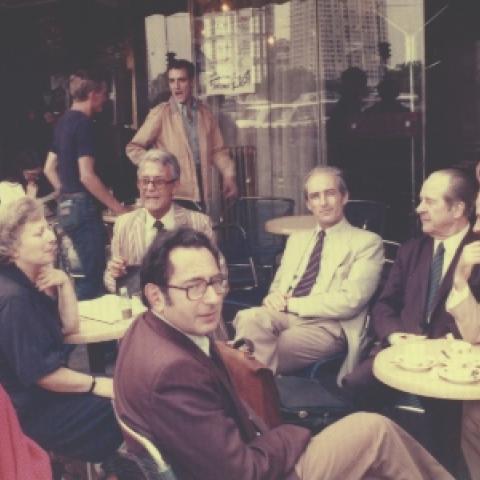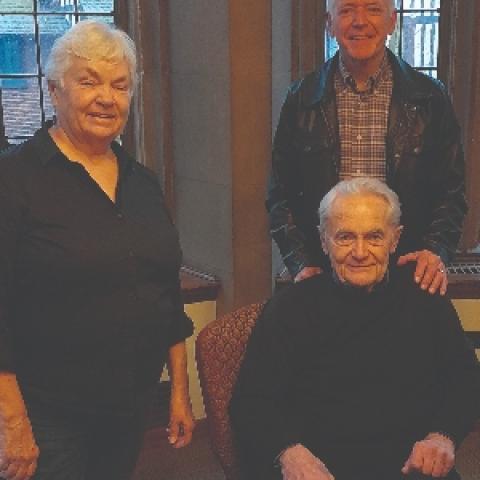
Photo: Thomas Gallia and Paul Déry in Milan, 1971 (photo credit: János Sebestyén)
New offering of János Sebestyén recordings
Longtime Southern Methodist University colleague and friend Robert Tifft has been my principal resource should information about a harpsichord recording be difficult to locate. When he sent me this material concerning the project for releasing historic recordings by one of Robert’s favorite artists I realized that I had never quite heard the entire story of how he became one of János Sebestyén’s best friends and promoters.
Robert responded that, as a young lad in 1979, he had spent nearly all of his record budget purchasing Gustav Leonhardt’s deluxe package of Bach’s Brandenburg Concerti discs (complete with a facsimile of the manuscripts), but still desired to access a recording of the Italian Concerto for Harpsichord. In searching for something inexpensive he came across the three-dollar Turnabout label performance by János Sebestyén, purchased it, and became fascinated by this central European’s artistry at the very first hearing. Correspondence was followed by telephone connections and visits to Hungary in future years, and Robert’s devotion obviously remains undiminished. While the current discs are primarily of organ performances, you will note that there is at least one lengthy bit of harpsichord repertoire on the first disc. Our thanks to Robert for his informative and delightful essay about a figure who deserves to be better known as a major proponent in the history of the twentieth-century early music revival.
—LP
§
The present edition encompasses the five recordings published by the Angelicum label in Milan with organist and harpsichordist János Sebestyén. Remastered from the original tapes and available here for the first time on CD, they represent not only Sebestyén’s first recordings published in Italy, but also the beginning of his productive collaboration with the esteemed audio engineer Thomas Gallia and his colleague Paul Déry. At the same time, they also help tell the engaging story of three Hungarians who found themselves making records in Italy during the 1960s.
János Sebestyén was born in Budapest in 1931 to musical parents. His father, Sándor Sebestyén, a prominent cellist, educator, and author, studied with Adolf Schiffer and Arnold Földesy. His mother, Rózsi Mannaberg, studied piano with Arnold Székely and Wilhelm Backhaus. Sebestyén’s formal musical education began in 1946 at the newly established State Music Secondary School where he was a student of pianist István Antal, organist János Hammerschlag, and composer Ervin Major. He continued his studies with Ferenc Gergely at the Academy of Music and graduated there with an organ diploma in 1955.
His association with the harpsichord came about in 1957 when he was asked to play the solo part in a performance of Frank Martin’s Petite symphonie concertante. This concert proved decisive, awakening interest in an instrument that was unfamiliar to many in Hungary at that time. With opportunities for organists being limited, Sebestyén quickly established himself as Hungary’s leading harpsichordist. Zuzana Růžičková in Prague was influential, encouraging him to play Bach, while in Hungary he inspired new works from composers Emil Petrovics and János Decsényi. His many recitals, radio broadcasts, and performances for television and film introduced the harpsichord to a large and enthusiastic public, and with his founding of the harpsichord department at the Academy of Music in 1970, he secured for the instrument a permanent place in Hungarian musical life.
From his childhood, however, Sebestyén dreamed of being a radio personality, and his association with Magyar Rádió (Hungarian Radio Corporation) began in 1950 upon the recommendation of composer Elek Huzella. His career there spanned more than fifty years, resulting in hundreds of broadcasts that included programs documenting his travels abroad, the history of Hungarian Radio, and comprehensive surveys of the great musicians of the past century. His popular monthly series From the Diary of a Radio Reporter meticulously reconstructed the past, both culturally and politically, through personal interviews and original sound documents. And it was at Hungarian Radio in 1950 that he first encountered Tamás (Thomas) Gallia and Pál (Paul) Déry, the two men who would become his closest friends and most frequent collaborators in the recording studio. Sebestyén provides the following account in his unpublished memoir:
I was familiar with Tamás Gallia from photos in the radio newsletter. I learned only on the very first day that he was the grandson of István Thomán. A smart, tall, handsome man with an Italian-like constitution and face, totally different from Pál Déry, a man considerably overweight even then, who was born in Szeged where his father had a hardware business. Déry was opting for a singer’s career and was on good terms with both János Starker and György Sebők. Tamás Gallia in his time was taking piano lessons from Béla Bartók, and thanks to the family traditions could claim acquaintance with half the music world. In spite of his Italian looks he was Hungarian, but completed secondary school in Milan and possessed full command of the Italian language. His father, Branco Gallia, was a bank clerk in Budapest, who was offered the director’s post of his bank’s branch in Italy, which he was leading as long as it was possible, but then came the war, repatriation, and other things that had to follow . . . .
The young Gallia proved to be an excellent music director, and in addition was attending the Technical University in the mornings and evenings as one of the first students of professor Tamás Tarnóczy. Déry at the same time was the dedicated director of all song-related programs due to his genuine attraction to opera.
Gallia, born in Budapest in 1921, was, in fact, descended from an illustrious musical family—his grandfather, István Thomán, studied piano under Liszt and was later Bartók’s teacher. After graduating with a piano diploma from the Academy of Music in 1944, he studied engineering at the State Polytechnic University. From 1947 he worked for Hungarian Radio, but in 1951 was suddenly transferred by the Ministry to become chief engineer for the state record label MHV, predecessor of Hungaroton. After the Hungarian Revolution in 1956 he worked in Paris, first for Pathé Marconi, then Disques Charlin, and from 1961 he was director of the Angelicum Studio in Milan.
Déry was also removed from his position at Hungarian Radio, where, according to Sebestyén, “two pillars of the director’s unit abruptly disappeared.” He was given a position as soloist with the Honvéd Art Ensemble and in October 1956 found himself on tour in China when the revolution broke out. In December, the ensemble departed by train to Moscow where they were to give a gala performance, but the members unanimously staged a strike and refused to perform due to Russian suppression of the revolution. Upon their return to Hungary, the entire ensemble was dismissed for political reasons. Déry then found work as an opera singer in Stralsund, East Germany, where musicians were still in short supply, performing the leading tenor roles. He eventually returned to Budapest and by 1965 found his way to Milan where he was initially employed as a copyist for the music publisher Ricordi. It was during this time that Gallia was working to establish Sonart, his own independent recording company, and Déry soon partnered with him in this venture.
Sebestyén first visited Italy in June 1963 for a concert in Rome at Sala Casella with János Liebner, a cellist then making a name for himself as baryton soloist. It was also during this visit that he first met and interviewed composer Miklós Rózsa. Their ensuing decades-long friendship culminated in Rózsa’s Hungarian-language biography Stories from My Life, compiled by Sebestyén from their dozens of taped interviews. Before returning to Budapest, Sebestyén visited Milan where Gallia was now director of the Angelicum Studio. The Angelicum, an imposing redbrick structure designed by Giovanni Muzio and completed in 1942, was an important cultural center attached to both a church and monastery. Sebestyén offers the following description:
On the ground floor there was a concert hall: from 10 AM to 1 PM rehearsals, at 4 PM an English-language film screening, from 6 to 9 PM pause, and at 9 PM another film screening. (It was the only foreign language cinema in Milan.) On Mondays there used to be concerts (no cinema that day) with the “Orchestra stabile dell’Angelicum” (a staff orchestra) with Bruno Amaducci from Lugano as director of music and Achille Berutti as continuo organist and harpsichordist—an excellent musician who passed away early. The organ, strangely enough, had its place under the stage, with several openings peeping out, and when not in service these were closed down and even covered with planks. Nobody suspected that deep down an organ was hiding. A genuine solution by the way. The second floor was dedicated to the finance director, the third to management, on the fourth the great recording studio, and on the fifth the music cabinets for the scores. The general director of the institution was Riccardo Allorto, a well-known and excellent music historian, and he decided on the repertoire and artists for the recordings. The ground floor corridor was decorated with the fancy covers. And the great grand master of this whole establishment was the rigid, yet highly respected, Padre Zucca.
Sebestyén was introduced to Allorto by Gallia, whose warm recommendation resulted in an invitation to play a concert with the orchestra the following October. The program included concertos by Haydn and Handel, and in the days before and after this performance, both works, along with two sonatas by Hindemith, were recorded on the concert hall’s “hidden” Tamburini organ. The records were published by the Angelicum label the following year, a milestone for Sebestyén:
This was the “Grand Overture”—the first two records made abroad. Bruno Amaducci was an excellent conductor, the orchestra was friendly, and the fact that within one session we succeeded to record a whole concerto was a revelation to me (in contrast to the Hungarian practice where one session might result in 7–8 minutes). Here in Italy this was all very natural, here time was money. It was a great learning experience. In Western countries recordings are being made like that . . . .
In 1967 Gallia visited New York with the prospect of establishing a working relationship with George Mendelssohn, the Hungarian émigré and founder of the Vox label. Mendelssohn accepted Gallia’s offer to produce recordings through Sonart, and upon the recommendations of both Gallia and Miklós Rózsa, Sebestyén was engaged as soloist. Mendelssohn initially offered Sebestyén an exclusive contract, but Gallia, already aware of Mendelssohn’s financial tricks, felt this would limit their opportunities and cautioned Sebestyén against accepting the offer. By this time, Gallia and Déry’s working relationship was well established, with Gallia responsible for the technical aspects of the recording and Déry serving as producer and editor. They were both assisted by Pasquale Soggiu at the Angelicum studio. Déry later became proficient with the technical aspects as well, and his patient good nature effectively balanced Gallia’s sometimes-tempestuous personality.
With a studio at their disposal, and a small yet flexible staff, Sonart was able to produce recordings quickly and economically. Sebestyén’s first marathon session for Vox began in February 1968, and once the initial four albums were complete, Gallia expected him to record additional material, out of friendship, that could be licensed through Sonart. This pattern continued for several years, with the Vox sessions resulting in additional recordings licensed to CBS Italiana, Ariston, and BAM.
Among these “friendship recordings” can be found the three remaining records published by Angelicum. The first to be completed was the Bach recital Dai XVI concerti trascritti per clavicembalo, recorded on the studio’s often-uncooperative Neupert harpsichord, the only instrument readily available to Sebestyén and Gallia. The master tapes are dated April 1968 although the record remained unpublished until 1973.
Melodie di Natale was recorded at the Church of San Carlo in Brescia. The precise origin of the church’s organ is unclear, but it is generally attributed to Graziadio Antegnati—member of the prolific Antegnati family of organbuilders active throughout northern Italy for two centuries. The description on the organ case reads: “This instrument, built in 1636 by the Antegnati workshop in Brescia, was restored by Armando Maccarinelli in 1958 under the technical direction of Luigi Ferdinando Tagliavini and Ernesto Meli.” Organist René Saorgin described the San Carlo organ as an ideal example of the Antegnatis’ art. The master tapes for Melodie di Natale are dated November 1969, and the record was published in 1972.
Following Melodie di Natale on the CD are selections from two records also recorded on the San Carlo organ, one devoted to works by Johann Speth, the other to compositions by Johann Gottfried Walther. The Speth master tapes, like Melodie di Natale, are dated November 1969, while the Walther dates from June 1970. Both recordings were licensed to the French label BAM, but were also among several releases, including Sebestyén’s recordings of Handel and Vivaldi flute sonatas with Lóránt Kovács and Telemann trio sonatas with members of the New Hungarian String Quartet, that were scheduled for publication by Angelicum in an attempt to revive their flagging record business. All of them, however, remained unpublished upon the label’s demise.
Bach’s Eight Little Preludes and Fugues, released in late 1973, was one of the last records to be published by Angelicum. The master tapes are undated, but the recording, made in the Rovigo cathedral, most likely dates from 1970 or the following year. The cathedral’s organ was constructed by Giuseppe Cipriani in 1832, then enlarged by Annibale Pugina in 1930 and again by Tamburini in 1960. Sebestyén vividly recalls the late-night session:
We recorded the Eight Little Preludes and Fugues as “guests”—meaning that Gallia was renting the cathedral for an orchestra, but with them the recording was finished by 10 PM and following a light supper came my turn at around 11 PM. I continued the work “in the dark.”
We finished around 4 AM—it was a real night rush, and outside the weather was miserable: thunderstorms and torrential rain, not like we were used to at home, but twice as vehement and double the volume of water, so typical of countries near the sea. At dawn all had to be taken down, things packed and transported through the side door under huge plastic covers. “You are a radio man,” I often remember hearing as a warning from Gallia, or rather as an order. “Here are the keys, shut everything off and close properly.”
I never was a worrying type, but that night, yes. I switched off the lights one after the other, hastily closed the doors, and found my way down on the stairs. The cathedral, dim as it was, gradually turned pitch black. Red candles, subdued sounds, small creaks, and stirrings—all this intensified by the darkness. Penetrating flashes of lightning filled the cathedral, and outside it rumbled ominously. I was inching my way in the darkness and felt relief upon finally seeing the dim light coming through the side door. Quickly, out through the falling rain and into the safety of the car waiting outside. Off we drove to Milan.
Only for a while though, because after a time the car began to jerk, and under an overhead bridge (fortunately) it stopped for good. Gallia looked darkly at Déry, “You did refuel the car as we agreed, didn’t you?” “Forgot . . . ,” groaned Déry. Covering his head with a plastic bag, petrol can in hand, he immediately started off in the direction of a luckily not too far away gasoline station. On return he was driven back by the station staff. This is how our Rovigo adventure happened.
János Sebestyén would perhaps be somewhat dismayed by the present edition. During a 1990 interview with music historian Allan Evans, he quipped in regards to these recordings and their subsequent reissue by the Ars Nova label that “. . . you cannot be free from the records, they are coming after you. You want to hurry away, but the records are following . . . .” Prescient words, for here they are, pursuing him yet again. But this time he need not fear. This edition is offered not to the critics or as a definitive testament to his art, but rather as a modest tribute to this remarkably versatile musician and the adept professionalism of Thomas Gallia and Paul Déry. It is a memento of their friendship, the Angelicum, and the city of Milan, Sebestyén’s second home, and in these respects he would no doubt be pleased. Déry died in 1992 and Gallia in 1997, their passing marking the end of Sonart as well. When writing about both men in his memoir not long before his death in 2012, Sebestyén reminisced over the old tapes and photos that document their time together, asking, “who will care about these in a few years?” The present edition answers that question.
Thanks to Dr. Judit Hidasi for her translation of passages from János Sebestyén’s memoir.
—Robert Tifft
Editor’s note: while the recordings are not yet available, readers are encouraged to follow progress: www.jsebestyen.org.
János Sebestyén’s recording of Melodie di Natale can be accessed on YouTube: https://www.youtube.com/watch?v=8OlIEBOQekg






